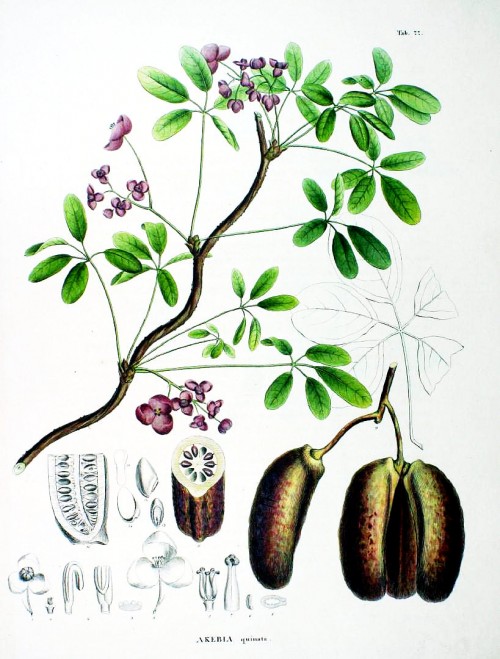Dies ist eine alte Version des Dokuments!
Akebia quinata (Houtt.) Decne. - syn.Rajania quinata Houtt.; Akebia micrantha Nakai. - Lardizabalaceae
木通 mu tong (chin.), アケビ Akebi (jap.), chocolate vine, five-leaf akebia, Fingerblättrige Akebie
Deciduous woody climber, 10m or higher, native to Eastern Asia (China, Korea, Japan), cultivated and naturalized elsewhere; leaves palmate, petiole 4-14cm long, leaflets 4-7cm long, 1-3cm wide, upper side dark green, underside pale green; inflorecences pendulous, 4.5-9cm long; flowers fragrant; male flowers 4-11, with 3 sepals, violet, with 6-7 violet to black stamens; female ones 1-3, dark purple, occasionally green or white, with 3-4 broad elliptic, up to 1.5cm long sepals; fruits purplish, oblong to ellipsoid, 5-8×3-4cm; seeds ovoid-oblong, seed coat brown to black, shiny, pulp white.
„The roots, stems, and fruits are used medicinally.“
http://www.efloras.org/florataxon.aspx?flora_id=2&taxon_id=200008288
„Akebia bark acts diuretic, anti-inflammatory, helps absence of menstruation and during breastfeeding. In addition, the fruit is said to heal cancer and the root to have an antipyretic effect.“
https://de.wikipedia.org/wiki/Fingerbl%C3%A4ttrige_Akebie
Dried parts (cutted crosswise in traditional manner) of the stem is known as Akebiae caulis (Japanese Pharmacopoeia). Said to act diuretic, antipyretic, antinociceptive, stimulating on ileus. Several triterpenoid saponins were isolated from A.quinata containing hederagenin and oleanolic acid as triterpene aglycon.
[Hagers Handbuch der Pharmazeutischen Praxis, Springer 2010]

Siebold, P.F. von, Zuccarini, J.G., Flora Japonica, t.77 (1875)
http://plantgenera.org/species.php?id_species=35439
